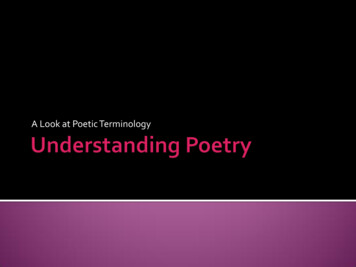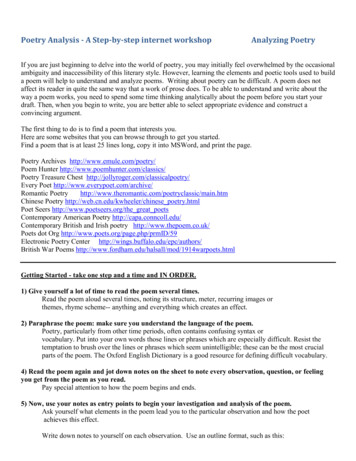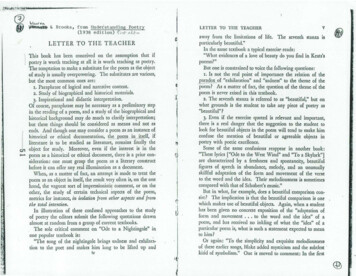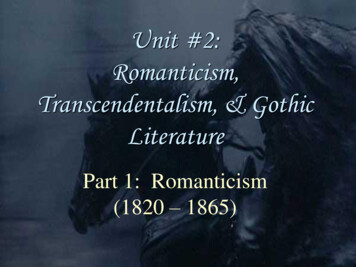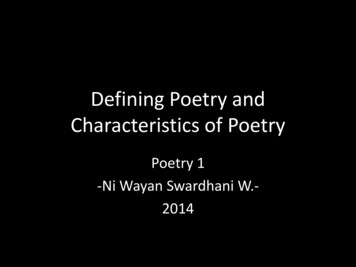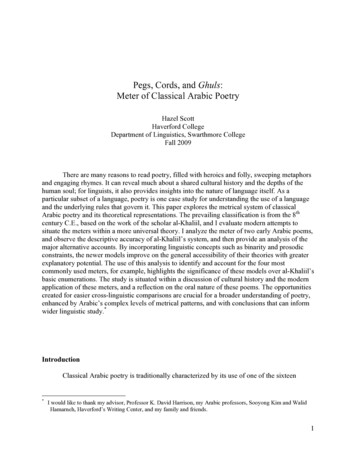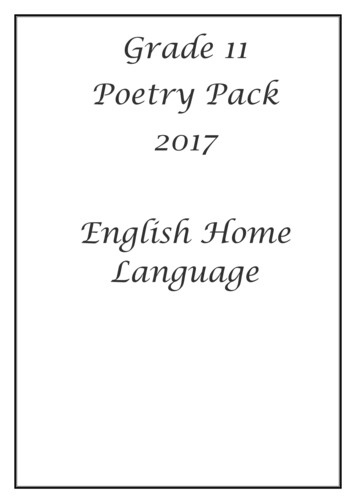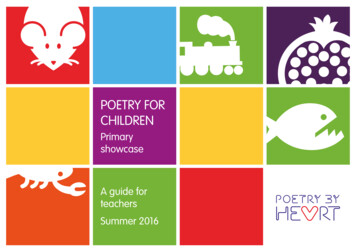
Transcription
POETRY FORCHILDRENPrimaryshowcaseA guide forteachersSummer 20161
“ The poems we learn when we’re young stay with us for the rest of ourlives. They become embedded in our thinking, and when we bring themto mind, or to our lips, they remind us who we are as people, and thethings we believe in. They become personal and invaluable, and what’smore they are free gifts – there for the taking. We call it learning by heart,and I think such learning can only make our hearts bigger and stronger.”Simon ArmitagePoetIcon by Agarunov Oktay-Abraham(The Noun Project)2
CONTENTSPoetry for children – Primary showcase4Mix it up poems6What’s on the toolbar7Taking a poem to heart8Organising a Poetry By Heart event9Poetry for life: research insights10Directory of poems11Sites for Primary poetry23Credits and acknowledgements27Icon by Michelle Whitaker and Lorena Salagre (The Noun Project)Front cover icons: Mouse; Darring Higgins, Pomegranate; Dominique Vicent,Fish; Luis Prado and Joe Harrison, Lobster; Creative Stall (All The Noun Project)3
POETRY FOR CHILDREN– PRIMARY SHOWCASEIn 2012, Poetry By Heart was launched as an England-wideschool poetry recitation competition for 14-18 year old pupils.The fourth competition took place in March 2016 at HomertonCollege, Cambridge. In some ways starting a national poetryrecitation competition was a new venture, but in others it wasan organised remembering of valued practices. Poetry recitationin school dates back to the beginnings of mass education andits rapid acceleration of literacy. For all the affordances of digitaltechnologies, reading rhyming verse with children and learningnursery rhymes is still a regular part of what we do in teachingchildren to enjoy language, to share in it, participate in it, andcreate with it.When Primary school teachers asked us if we could developsome poetry recitation resources for them to use in class, we weredelighted to help. The resulting showcase collection of 60 poemsis designed to help Primary school pupils and teachers find poemsthey love, and enjoy them together through reading aloud andlearning by heart. There were some very tough decisions along theway and we have not finished yet: we hope to add more poemsand more recordings in audio and video form.The showcase offers children a diverse and enticing mixture ofpoems, classic and contemporary, surprising and familiar, thatare all perfect for reading aloud. There are classic poets whowrote poems for children, or poems suitable for children, likeWilliam Wordsworth, Robert Browning, John Keats, Emily Dickinson,Robert Louis Stevenson and Edith Nesbit. There are also some of thebest contemporary poets who write for children today such asJackie Kay, Tony Mitton and Philip Gross. The collection includesa wide variety of times, styles and voices from the UK and beyond.The poems offer many different kinds of pleasure for reading,learning and sharing aloud. Some poems tell stories, othersrelive moments of realisation, observation and discovery. Thereare serious poems and silly poems, long poems and very shortpoems, traditional rhyming poems and free verse. Some will suitindividual recitation, others are good for paired readings andshared readings, choral readings and dramatic performances.The activities that accompany the poems encourage enjoyment,exploration, experiment and understanding. We hope you will findnew treasures and old pleasures, and enjoy sharing these poemswith the children you teach.This guide has been designed to be read on-screen with linksto the poems and additional online resources embedded in thetext. We intend to add new poems to the site and to update theguide when we do. If you have subscribed to our mailing list, wewill automatically send you updates. If you haven’t and wouldlike to receive these, or you would like to add other colleaguesto our list, please register here. We welcome your feedback viainfo@poetrybyheart.org.ukJulie BlakeCo-founder and director, Poetry By HeartIcon by Matthew Hawdon (The Noun Project)4
“ The range of poems in the Poetry for children Primary showcase resourceis great. It allows every child access to high class poetry to be inspiredand challenged by. With a new focus in the curriculum on learning andreading poems by heart, this is also a fantastic resource for teachers.The accompanying online resources are well presented so that childrencan develop independence within the learning process and explore thepoems in different ways.T he website is very engaging and has been well designed to support alllearners such as those with dyslexia. The inclusion of a widget for childrento record themselves speaking their poem and hear their performance backis a brilliant, easy to use way for them to critically evaluate and improve theirperformances. I can’t wait to use this resource with my own class.”E mma KesperDeputy Head and Subject Leader for English at Sedlescombe Church of England Primary School, East SussexIcon by Marcio Duarte (The Noun Project)5
MIX IT UP POEMSOlder pupils taking part in the Poetry By Heartcompetition often talk about the strong motivationfor learning that came from first finding a poem theyloved in our collection. The Poetry for children Primaryshowcase has been designed to make exploringpoems fun. It encourages independent exploration byoffering playful visual and textual ‘lures’ to the poems,breadcrumb paths to other poems, random rabbit holeadventures, and the opportunity to mix it all up and starta completely new voyage of discovery.Click the “mix it up” button to jumble the poems up andspark new ideas and connections.6
WHAT’S ON THE TOOLBARWith audio, video and text versions there are many ways of enjoying the poems. Eachone is enhanced by activities that celebrate and develop voice, language, imaginationand creativity. Look out for some or all of the following icons on the poem pages to help youand your pupils explore what the site has to offer.POEM ACTIVITYLISTENEach poem is associated with a unique activity. Pupils might tackle themindependently - on their own or with friends and family - or they could be thestarting point for a lesson.Listen to a poem being read by a poet.Example activity for ‘Eletelephony’ by Laura Richards:Have fun with the poem by trying this.This poem is quite a tongue twister. Read it slowly a couple of times silentlyand then read it out loud slowly. Now you have got used to the sounds of thewords and pronouncing them see if you can read it out loud really quicklywithout tripping over the words. Good luck!PRINT PAGEA printer-friendly version of the poem without the illustrations to save that allimportant printer ink!SHAREThe arrow tool invites you to share the poem on Facebook and Twitter – a tool forteachers and parents!WATCH VIDEOPress play for a video transcript of the poem, read by a contemporary poet.Pupils can begin to appreciate the relationship between the form of the poem andits sound.RECORDYou will only see this icon if you have the latest browsers, a microphone, and speakers.If your browser does not support a microphone it will not be available to you.Things to check before recording: Y ou might see a pop-up message that says Poetry By Heart wants to use yourmicrophone. Click ‘allow’. C heck that you don’t have a pop-up blocker enabled on your web browser.This will show an icon of a video camera with a red cross through it in thetop right-hand corner of your screen. You need to click on this and choose todisable it on the Poetry By Heart site in order for the record function to appearon the sidebar of a poem page. I f your browser says ‘missing plugin’ you may need to download aprogramme like Adobe Flash Player in order to use all the functions on thesite. Follow the instructions on your computer to install the suggested plugin.To record: Hover over the microphone icon on the poem page sidebar. C lick the red record button to begin. The button will pulse to let you know thatit is recording. S peak into or near your microphone and when finished click the stop button. Click the play button to listen back to your recording. If you aren’t happy with it, start the process again to re-record. If you are, click the arrow icon to download the recording as a file to your computer.7
TAKING A POEM TO HEARTGet to know the poemIt is helpful to think of a poem as a living thing. Recent researchin neuroscience suggests that the brain responds to works ofart, including poems, in the same way as it responds to people.Learning a poem is like getting to know a person – it takes time.Another helpful way of thinking about a poem is as a written textwith multimodal dimensions. To bring it alive in its fullest form, pupilsneed to experience it through reading it, listening to it being readand speaking it aloud. Teachers have a key role to play in modellingthese approaches, especially in reading poems aloud to the class.Poems need to be read and reflected on many times to revealthemselves. Readings might be silent or aloud, individual andtogether, and there should be time to talk and share enjoyments.It can be interesting to listen to different readings of the poem, bypupils themselves as well as by expert readers, including poets.We have included some audio recordings on the website and theresources section of this guide will point you to particularly goodsources for more. The activities accompanying the poems on thewebsite very often suggest ways of engaging with the poem asa spoken form.Listening to and trying our different readings can help pupils to findtheir own appreciation of the poem. Poetry By Heart competitorsoften tell us that this kind of personal meaning-making was thecritical first step in learning their poem by heart. The followingmethods will help you and your pupils take this initial explorationfurther and could be used in lesson planning.Prepare a reading aloudRead each line several times and try emphasizing different wordsand phrases. Try different tones of voice in different parts of thepoem. Think about pace, volume and timing. Think about to voicesound patterns, rhyme and rhythm. When you have worked outhow best to read it aloud, try marking up a copy of the poem toshow this using highlighting and other annotations.Embody itMovement is a powerful memory trigger as well as a goodway of exploring the poem’s form. Some pupils might find ithelpful to sing, chant, clap, dance or drum the poem as way ofexperiencing its sounds and rhythms. The challenge is then toinclude a sense of that musicality in a recitation of the poem.If you have enough space get pupils walking as they say lines ofthe poem aloud – try different speeds, and stops and starts, to fitthe poem’s pace and rhythm.Icon by iconsmind.com (The Noun Project)Teachers tell us that their primary pupils memorise their poemseasily, enjoy doing this, and find it helps them to commit otherinformation to memory. If you want to find out more about methodsfor memorisation take a look at poet Ted Hughes’s ideas in theintroduction to his anthology, By Heart. There are also books andwebsites about how to memorise by Tony Buzan among others.Secondary school teachers entering their pupils for Poetry By Heartcompetitions tell us that they respond well to the teacher learninga poem alongside them. Here we offer some approaches whichpupils and teachers have used to help them take a poem to heart.Move itInvolve pupils in making up movements and gestures to go withlines of the poem. This is a fun way to enjoy the poem togetherand it will make learning the poem by heart a sociable activity.The result could be the basis of a class performance in itself.Record itThe website includes a recording device (if you have the rightbrowser) and you may have access to other recording technology.When pupils record themselves, they often want to rehearse thepoem and re-record it seventeen times until they are happy withit. They can also play the recording back as a means to learn it.They could also record a version leaving a pause after each line orcouple of lines, to allow them to repeat it aloud while they listen.Make a poem posterAnother way that pupils might explore their appreciation of thepoem is through visual design. You could show them WilliamBlake’s ‘The Tyger’ in its original print form, richly illustrated andwith a print representation of his handwriting. In fact, the processof handwriting is linked to memory and the action of puttingpen to paper can help to improve recall. Pupils could write outand decorate their poem with patterns and pictures, then take amental snapshot that they can visualize when learning it by heart.8
ORGANISING A POETRY BY HEART EVENTHaving run Poetry By Heart a number of times now, we know lotsabout recitation competitions but that isn’t necessarily where youwill want to start – or finish. Thinking about poetry as a sharedin-the-moment experience, on the other hand, is a really fruitfulidea. Poetry is an oral form and it needs speakers and hearersto bring it fully alive. The former American poet laureate, RobertPinsky, advocates an inclusive ‘Favourite Poem’ model for this.Everyone chooses a favourite poem and has to read it aloud toeveryone else, also saying why they chose it. Simple. Find out lotsmore at www.favoritepoem.org/teachers.htmlSome poemsBut poetry recitation is very special. It brings its speakers andlisteners even closer together. In even the liveliest classroomsyou can hear a pin drop when someone recites. We think it issomething to do with having nothing in the way of the soundof the words, just a voice speaking to you directly. There isalso respect for the risk it involves, the same breath-takinganticipation as watching someone walking a tightrope. It isalways a precious moment. A recitation competition canfocus that and encourage pupils to stretch to a higher level –a challenge we think is both serious and fun!Some judges and judging criteriaWhich poems will pupils recite? You could choose from ourselection, or set a selection of your own. Alternatively, you can letpupils pick a poem of their own choice but you can hear ‘The Owland the Pussycat’ too often! The reason we set an anthology forour competition is so that pupils who don’t come from a houseof books are not disadvantaged by not knowing where to beginchoosing. If your pupils speak other languages and can findpoems to recite in them, then it could be a wonderful way to shareand celebrate diverse cultural heritages.This could be the class teacher and learning assistants, parentsor a local poet. Decide what a good recitation will look like or useor adapt our judging criteria, scoring for Voice, Understanding,Performance and Accuracy. Download criteria and scoresheetsfrom the ‘Competition resources’ page. One judge can beenough, although if you’re judging accuracy as well you’ll needtwo, and we recommend three – two recitation judges and anaccuracy judge. A prompter and score keeper are useful too!An eventTo hold a recitation competition, you will need:A formatHow many poems will pupils recite? One might be enoughalthough teachers tell us that makes judging harder, as there isless to choose between pupils with only one poem. You couldhave a first round with one poem with the best going throughto a second round with two poems. Do you want pupils torecite individually, in pairs, or chorally in groups? You couldhave different categories to suit pupils with different strengths.Will your competition take place in class, assembly, or at an afterschool event? All you need is space so that everyone can see andhear the reciters easily – especially the judges! If a microphone isneeded, make sure pupils can rehearse with it. We recommend4-5 minutes per recitation to allow time for the poem and scoring– that will be plenty of time and you won’t over-run. There is asample event schedule on the ‘Competition resources’ pagenoted above and a certificate template.Questions? Drop us a line at info@poetrybyheart.org.ukIcon by B. Agustín Amenábar Larraín (The Noun Project)9
POETRY FOR LIFE:RESEARCH INSIGHTSNow that we have a thousand poems quite literally at our fingertips– on tap – why should we bother keeping any in our heads?Although poetry learning and recitation has been reinstated onthe primary curriculum, as with many policy initiatives the movewas made with little research evidence to indicate why (or indeedwhether) the memorized poem may be of value. The Poetry andMemory Project at Cambridge University has been investigatingthis very question for the past two years. We are still analysing alarge quantity of gathered data, but already a number of points areemerging about poetry learned early in life: Poems are usually learned with relative ease. In fact many ofour adult participants told us they learned poems as childrensimply because they wanted to, and many relished the senseof achievement. They often stay in the memory for life, though for some theyslip away. Poems that are retained often gain value for people over theyears, acquiring layers of meaning from life’s experiences– and giving those experiences meaning and a form ofexpression in return.and auditory aspects are activated every time it is read aloud.But by bringing the poem into memory and speaking it (even toourselves) from within the body, its music seems to sound moreclearly. We may find, as Seamus Heaney says, ‘a music younever would have known/to listen for’.Become a living thingA memorized poem is taken inside us where it becomes a livingthing. This poetic metaphor is a physical reality: the acousticpatterns and visual images are encoded within our neurologicalpathways. Once there, they may make connections with otherpatterns and images in ways that are enlightening, pleasurableor surprising.Be ownedThe memorized poem becomes our poem. This sense ofownership may play a vital part in developing a relationship withpoetry. It establishes a sort of base camp whence we can makefuture forays. And for many of us, the known poem becomesstrongly associated with certain people, places or times in ourlives – a thread in language that connects us to our own feelingsand experience.Have time and space to unfold Poems that slip away still leave their impression. As SeamusHeaney suggests, they have a role in “bedding the ear with akind of linguistic hardcore that could be built on some day”.A memorised poem is more likely to:Let its music soundPoetry is a multimodal form in which sound is dominant, so ithas an important relationship with the body. A poem’s phonicEducation has shifted its objectives from acquiring knowledgeto learning skills – including the skills to find the things we needto know, as we need them. It reflects wider society, whereknowledge is increasingly situated externally, to be used adhoc. To learn a poem, however, is to make time and space for adifferent kind of knowledge within ourselves. As the poet CharlesCausley once said, “if, say, 80 per cent of a poem comes across,let us be satisfied. The remainder, with luck, will unfold during therest of our lives”.Debbie Pullinger and David WhitleyThe Poetry and Memory Project, University of CambridgeIcon by Vicons Design (The Noun Project)10
Icon by iconsmind.com (The Noun Project)Directory of poemsPages 11-21 list the poems you will find on the Poetry By Heart Primary showcase along with a briefdescription of their potential for classroom learning. The sixty poems are listed A-Z by poem title andclicking on the image will link straight to that poem on the website. You can use these pages to helpplan teaching and in class to go straight to a particular poem rather than finding it from the“mix it up” home page.These poems were selected by Morag Styles, formerly Professor of Children’s Poetry at the Universityof Cambridge. Read Morag’s argument for the importance of poetry in children’s education here.A Bird Came Downthe Walk‘ He bit an angle-worm in halvesand ate the fellow, raw’This charming poem is typical of Emily Dickinson’s sharp observations which usesimple but evocative language. Children of all ages will be able to picture thebird she describes, and the activity encourages children to link this to their ownobservations of birds. It is a straightforward and enjoyable poem for children toread out loud.‘Do you ask what the birds say?’An evocative poem, where a child imagines what different birds may besaying in their songs. The activity marries this 19th century poem with moderntechnology, using the web to allow children to listen closely to bird song and usetheir own imaginations to think about the power of birdsong. If the opportunitypresents itself, this could link wonderfully to outdoor learning.Emily DickinsonAnswer to aChild’s QuestionSamuel Taylor ColeridgeCargoesJohn MasefieldCasabiancaFelicia Hemans‘ Emeralds, amethysts, Topazes, and Some of the language and the images in this short poem will be familiar tochildren, others may not, though all will be familiar with the idea of differentcinammon, and gold moidores.’cargoes ships may have carried in the past or in the modern day. The activityencourages the reader/listener to enjoy the feel of the language and be inspiredby this to write their own verse for the poem.‘ The boy stood on theburning deck,Whence all but he had fled;’The opening line: ‘The boy stood on the burning deck’ is much better knownthan the title of a poem which was hugely popular in the heyday of poetryrecitation. A powerful and challenging poem about war, bravery and duty theactivity invites older children to file a news report for television based on theevents of the poem.11
Child’s Song in SpringEdith NesbitDouble TroubleJackie KayEletelephonyLaura RichardsEscape at BedtimeRobert Louis StevensonExtinct‘ The willow is smart in asuit of yellow,’In this poem Nesbit describes 11 different trees which gives the perfect invitationfor children to find images of trees or actual trees and consider the effect of thepoet’s descriptions. The activity extends this to encourage fun actions also.‘ We were Laurel and HardyWe were Jekyll and Hyde’A perfect poem to explore the idea of opposites, and also the idea of thenumber two. It could be used as a link to the mathematical concept of pairs,or to introduce ideas about friendships and relationships. With accessiblelanguage and a simple list structure, the activity encourages paired readingand performance.‘ Once there was an elephant,Who tried to use the telephant.’A simple, playful poem that has a lot of fun with the words ‘elephant’ and‘telephone’ and is enjoyable for out loud reading. Older children can beintroduced to other kinds of word play such as spoonerisms and could beinvited to create and control language after looking at examples.‘ The lights from the parlour andkitchen shone out ’The poem evokes a child’s sense of wonder at the thousands and millions ofstars in the night sky mentioning certain constellations at one point. Written intwo eight-line verses rhyming a-b-a-b the formal structure of the poem canbe discussed as can the way in which the child observes the stars but is alsoobserved by them.‘ Our stories all begin with ‘Once’,’A thought provoking poem about animals which have become extinct, withan activity designed to support children in thinking more about this importantenvironmental issue.‘ Great rats, small rats,lean rats, brawny rats,’This extract from the classic narrative poem which has entranced readers forgenerations describes the piper leading the rats from the houses and thenasking for his payment. A brilliant poem to read out loud to children, perhapsas part of telling them the full story. The activity allows children to enjoy thelanguage, playing with voice and volume to convey the movement and dramaof the poem.Mandy CoeExtract fromThe Pied PiperRobert Browning12
Fisherman ChantJohn AgardThe Peacock at HomeCatherine Ann DorsetGranny IsValerie BloomHiawatha: FishingHenry Wadsworth LongfellowHouse of AirPhilip GrossHow to Cut aPomegranateImtiaz Dharker‘ From my boat I cast my net toyour heart ’This poem could be used to develop movement and mask work and also lendsitself well to choral recitations. The very short, three or four syllable lines and theuse of repetition to enhance the chant like qualities of the verse can be exploredas can the relationship between the narrator and the river.‘ The peacock resplendent,unfurl’d his broad fan,’This is a lovely, long poem to read out loud or to listen to. The activity supportschildren in joining in with the reading out loud of a poem without the need for themto read whole sections themselves (just focusing on the names of the birds). Theactivity then uses the poem as a springboard for discussion about birds. This isa great example of a chance to use a relatively long poem in an engaging way,building children’s confidence with longer poems.‘ Granny is stories in themoonlight ’This poem of 25 short lines by the Jamaican born poet Valerie Bloom can helpintroduce children to poems from other cultures and the use of dialect in poems.The suggested activity offers children a chance to imitate the style and structureof the poem in thinking about the special people in their lives.‘ On the white sand of the bottomLay the monster Mishe-Nahma,’This is an extract from the classic longer poem, and would work well to beread out loud to children so the rhythms and power of the language can befelt (without the need for the listeners to understand every word). The activitysuggests using a section of the poem to help children feel the strong rhythms ofthe poem through a clapping exercise.‘ A letter was sent but no one wasthere’The poem focusses on the mysterious disappearance of the house betweennumbers sixty eight and sixty four. Children can discuss what might havehappened to the house and why the poet has chosen not to use any punctuation.Children can prepare a reading of the poem where, in the absence of punctuation,they have to make choices about pace.‘ The pomegranate reminded methat somewhere I had anotherhome.’This poem explores the speaker’s enjoyment of cutting and eating pomegranates,though it also works on a deeper level in that it connects her to another countryshe also calls home. Children can explore the poem on different levels – exploringthe look, feel, taste of fruit or thinking about connections between food and family/belonging. The activity uses the poem to encourage children’s own description offruit – a perfect opportunity to eat some fruit together in class?13
Hyena‘ I am waiting for you.’A powerful, imaginative description of a hyena in a poem where the free verse,the use of first person and the relatively straightforward language contribute toour sense of the animal. The activity supports children in being inspired by thepoem to write about an animal which fascinates them.‘ I wish I could tell youthat I like you a lot ’This poem creates six four-line verses around pairs of things: ‘carrot sprout’;‘conker string’ etc. The pairing idea is reinforced in the rhyming of the secondand fourth line in each verse. The activity invites children to create their own pairsof objects in four line verses using the poem as a model.‘ Now those littlewords are sprouting’This poem works well within lessons introducing children to poetry as a genre.When read out loud by the teacher children can be encouraged to explorethe idea of a poem growing and developing in the imagination like a seedbecoming a flower. The activity invites children to create their own poeticinstruction manuals.‘ My name gets called in awhisper ,’This poem, suitable for use with Key Stage 2 children, invites discussion ofindividuality and diversity and how we and those around us use names to conveydifferent feelings in different situations. The activity invites children to play with thesounds and rhythms of their own names, creating something quite magical inthe process.‘ And how the long dusty roadseemed to have for meNo end, you know.’The simple language and repetition of ‘remember’ and ‘long ago’ build to makethis a moving poem about a childhood memory. The activity asks children to writeabout a happy memory of their own and the strong, straightforward images in thepoem can help children describe scenes they remember themselves.Edwin MorganIf You Were a CarrotBerlie DohertyInstructions for GrowingPoetryTony MittonIsn’t My Name MagicalJames BerryIt Was Long AgoEleanor FarjeonJamaica MarketAgnes Maxwell-Hall‘ Plantains, wild-thyme, pallid leeks, This eighteen line-poem written in rhyming couplets contains referencesto about thirty different foods and brings to life the richness and colour ofPigeons with their scarlet beaks,’the market. Children may need some support in identifying all the fruit andvegetables mentioned but the poem is excellent for exploring the relationshipbetween sound and meaning.14
Lament of anArawak Child‘ They made my people intoslaves’Born in 1942 the Jamaican poet Pamela Mordecai writes a moving lament inthe voice of a Jamaican Arawak child trying to come to terms with a time whenthe ‘strange men came and took this land’ in the fifteenth century. The activityencourages research in to the history of the Arawak people.‘Little trotty wagtail hewaddled in the mud’Written in the early 19th century, Clare’s description of a wagtail bird ‘titteringtottering’ in the rain beautifully conveys the movement of the little bird vividly fortoday’s readers. The activity supports children in describing birds they may know,focusing on verbs to describe movement and also having fun with actions.‘ I love to sit and bay the moonand keep fat souls from sleep.‘An unsentimental poem written in pacy rhyming couplets that invites discussionof what kind of a dog is speaking in the poem and the character that emerges.Lots of opportunities here to talk about the use of adjectives, repetition,alliteration and assonance. The activity invites children to write a poem inrhyming couplets about anothe
The poems offer many different kinds of pleasure for reading, learning and sharing aloud. Some poems tell stories, others relive moments of realisation, observation and discovery. There are serious poems and silly poems, long poems and very short poems, traditional rhyming poems
